The kitchen has traditionally been a space where people gather, not only to enjoy and share their culinary arts, but more importantly a place where family, friends and neighbors share their stories of joy and pain. The kitchen is the space where knowledge is passed from generation to generation, the space where we all feel comfortable and safe not only to gossip (something of course, not of the slightest importance), but also to talk freely about community affairs and the way politics impacts our day to day lives. Following with this tradition,the Tamejavi community established the Cultural Kitchen in 2004. This month Tamejavi Fellows and Coordinating Group members gathered at the Cultural Kitchen with the intention of sharing knowledge and finding ways to support each other through the TCOFP journey. At this Cultural Kitchen not only did we eat delicious food, but we also learned how indigenous peoples for centuries, used their creativity to overcome poverty by using the natural resources that surrounds them to cook delicious organic meals. We also learned how spices such as cumin, and grains such as rice, have crossed continents. Enjoy reading the experiences of those who attended this distinctive event.
My First Cultural Kitchen
Minerva Mendoza, Coordinating Group Member
The TCOFP Cultural Kitchen was unlike any other events I have ever been part of; it was different in the sense that at this event the participants had a good dynamic going on. I was glad to see that everyone came with an open mind, willing to learn from others and try new things. The Coordinating Group members and Tamejavi Fellows, were eager to interact with each other.
During the presentation, it was interesting to hear the history each person had about their dish. One story that struck out to me, because I could relate to it, was that of Sokha Serey. Even though we both come from different cultures, we have many similarities. Sokha mentioned that her dish was very traditional and, “if you are Cambodian you have to know how to cook it and eat it.” My mother always says to me that if you are from Santa Maria Tindu (Oaxaca Mexico), the town where I was born and raised, you have to know how to make the spicy mole and be able to eat it. Aside from the stories I, along with others that were present, noticed that some of the ingredients were the same. Some of the ones that became evident were: cumin, cilantro, and rice, which to me was interesting because communities from across the world seem to use these ingredients.
I have to say that the part of the Cultural Kitchen that I enjoyed the most was the eating part. I feel that the excitement to try the different dishes was building up as the presentation went along. Therefore, when it was finally time to eat, I was more than ready. Something interesting I noticed was that everyone sat next to people that were from a different community, instead of sitting with people from their own community. All enjoyed the delicious food while they talked with each other about what their country is like, what their customs or traditions are, and about what things they are involved with in their communities. I think this shows that at this event everyone was comfortable enough with each other that they did not need to go out of their comfort zone. This made me feel that the purpose of the event(to have both groups form a relationship in which they can support each other and exchange information and knowledge) was accomplished.
Arroz con Pollo
Estela Galvan
The cultural kitchen was a great success despite the warm weather. Everyone who participated took great joy in sharing their culinary practices. It was interesting to learn how many of our dishes are influenced by one another’s cultures; as in the case of my grandmother’ssouthern Texas dish of Arroz con pollo. My rice-based chicken casserole was similar to the dish that Tahereh prepared.
As I thought more about this dish, which became a staple in my family, I looked into the history of rice and cumin; the two key ingredients. As far as cumin seed, it was introduced to America by the Spaniards but it’s originally from Iran and the Mediterranean. Coincidently, today cumin is cultivated and grown in many countries including India, Iran, Mexico and China countries that many of us descend from. In regards to the rice, which was also introduced to America by the Spaniards originated in China and was first spread to countries such as Sri Lanka and India.
As you can see, like it or not we are bonded by the foods we eat. I look forward to learning more from each of you and hope we continue to find ways of relating, regardless of our cultural differences. Personally, I would like to think that this dish is part of my ancestral history and grateful for the journey these ingredients took me as they now remind me of my grandma Paula and her adaptation of Arroz con Pollo.

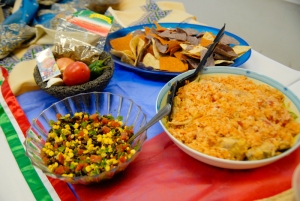


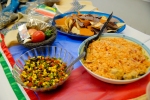
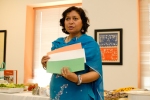


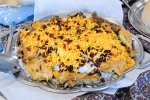

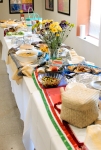
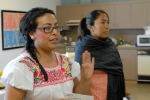
I had an awesome day, thanks everybody for bringing a dish, and teaching me a little about your traditional foods.
Thank you everyone! I had an amazing day with all of you.
A mi me gusto todo lo que compartimos en la cocina cultural porque nosotros los oaxaquenos tenemos diferentes maneras de preparar la comida pero yo mire
que la mayoria de ingredientes lo usamos en diferentes culturas, a mi me gusto lo que compartio Rosa de su comida que le trae recuerdo de su nines que es atole de papas.
Reblogged this on Tamejavi Fellows and commented:
A mi me gusto todo lo que compartimos en la cocina cultural porque nosotros los oaxaquenos tenemos diferentes maneras de preparar la comida pero yo mire
que la mayoria de ingredientes lo usamos en diferentes culturas, a mi me gusto lo que compartio Rosa de su comida que le trae recuerdo de su nines que es atole de papas
The comment below is actually from Taheri and I’m positing it here to continue the dialog. Very nice to see the response of some of you in regards to this event, hope we will see even more. Thank you:
Dear TCOFP’s fellows,
Tha Cultural Kitchen event on April 21, 20012 was one of the best programs I have attended. We brought the world in a small room with great people of different communities and wonderful food.I had the great opportunity to taste different food and to get to know my fellow members and the members of the coordinating groups of TCOFP. By tasting unique dishes, I realized so many similarities between our food. For example, I noticed the dish I brought was so similar to Estela’s dish. I had so much fun trying different types of food and listened to stories of dishes from different parts of the world. I also felt so comfortable talking to TCOFP’s fellow and coordinating groups.
Good afternoon everyone,
I would like to offer another opportunity for cultural Kitchen in my house, but I would like to know how many people can come. Please let me know what date, time and month that it is good for you. I was thinking about June so that it still not so hot. Please let me know. My cell 930-8073 or email me.
Bee
The food was delicious. I think it would be cool if we have a cooking class where we get to learn how to make cultural dishes.